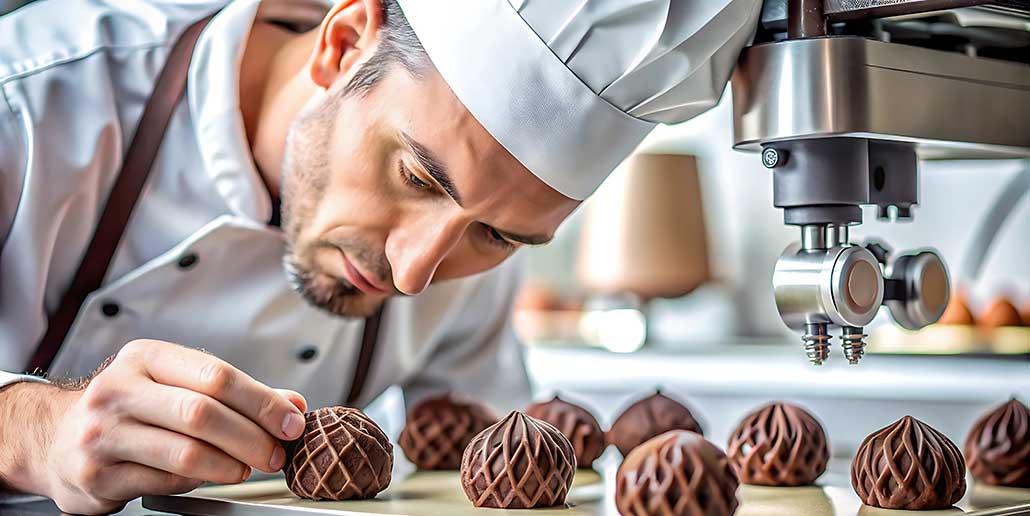
3D Printed Chocolate
Chocolate has always been a symbol of indulgence, celebration, and craftsmanship. But now, with the rise of 3D printing technology, it’s also becoming a playground for innovation. From personalized gifts to architectural dessert designs, 3D printed chocolate is pushing the boundaries of what’s possible in the world of sweets. This revolution is not just about aesthetics—it’s also about creating deeply customized, tech-enabled confectionery experiences that delight all the senses.
How 3D Printed Chocolate Works
At its core, 3D printed chocolate operates on the same principles as traditional 3D printing. Instead of using plastic filament or resin, it uses melted chocolate as the medium. The chocolate is loaded into a temperature-controlled cartridge and extruded through a nozzle in thin layers to build up the design. These designs can range from simple shapes to complex, geometric sculptures that would be nearly impossible to achieve by hand.
Specialized printers, such as those developed by companies like byFlow, Chocolate3D, and CocoJet, allow chocolatiers and businesses to transform digital designs into edible works of art. The process requires careful temperature control, as chocolate must remain fluid enough to be printed but solidify quickly to hold its shape.
The Rise of Personalized Chocolate Experiences
Customization is a growing trend across many industries, and the confectionery sector is no exception. Consumers today seek products that reflect their identity, tastes, and occasions—and 3D printed chocolate is uniquely positioned to deliver on all fronts.
Imagine walking into a chocolate shop and using a touchscreen to design your own chocolate bar—choosing everything from shape, text, and logos to flavour infusions and fillings. That level of personalization not only enhances the customer experience but also turns a treat into a memorable keepsake. Whether it’s a wedding favour engraved with the couple’s names or a company logo moulded into a truffle, these unique creations are reshaping how we think about sweets.
Innovations in Flavor and Form
Beyond just customizing appearance, 3D printing is enabling more creative flavor and texture combinations. Designers can create internal structures within the chocolate that influence how it melts in the mouth or how it delivers bursts of flavor. Hollow chambers, layered fillings, and even multisensory experiences—such as combining chocolate with edible scents or sound-enhanced packaging—are becoming increasingly feasible.
Some startups are even experimenting with functional chocolate, embedding vitamins, adaptogens, or CBD into customized shapes to create tailor-made wellness treats. The future of chocolate may not only taste good but serve a personalized health function as well.
Business and Industry Applications
The potential for 3D printed chocolate extends far beyond the individual consumer. High-end restaurants are incorporating it into their dessert menus, offering showstopping finale pieces that wow guests. Luxury brands use it for edible marketing, producing custom chocolates for product launches and influencer gifting.
Event planners, wedding designers, and experiential marketers are finding new ways to integrate edible technology into their work. With the ability to print on-demand or in small batches, 3D printing allows for creative flexibility without the cost and waste of traditional molds.
Even educational institutions and culinary schools are beginning to teach the use of 3D food printers, preparing the next generation of pastry chefs and chocolatiers for a tech-forward future.
Sustainability and Reduced Waste
While chocolate production has its own environmental challenges, 3D printing can help reduce waste by using only the necessary amount of chocolate for each design—no molds to clean, no overproduction, and minimal trimmings. The ability to produce items on demand also means fewer unsold products and less packaging waste.
Some printers are being adapted to work with alternative chocolates, such as vegan or dairy-free blends, broadening the inclusivity of the confectionery experience. As consumers become more eco-conscious, the fusion of sustainability and personalization may drive future innovation even further.
The Future Is Sweet—and Smart
As 3D food printing evolves, the chocolate industry is likely to be one of its most creative and commercially viable arenas. With advancements in software, materials, and printer precision, we can expect to see more integration of AI in design suggestion tools, enhanced flavor pairing algorithms, and mobile-based customization apps for real-time ordering.
In a world where tech meets taste, 3D printed chocolate offers a perfect blend of creativity, indulgence, and personal expression. Whether it’s for a celebration, a brand experience, or simply a sweet craving, the future of custom confectionery is undoubtedly delicious—and deeply personal.

